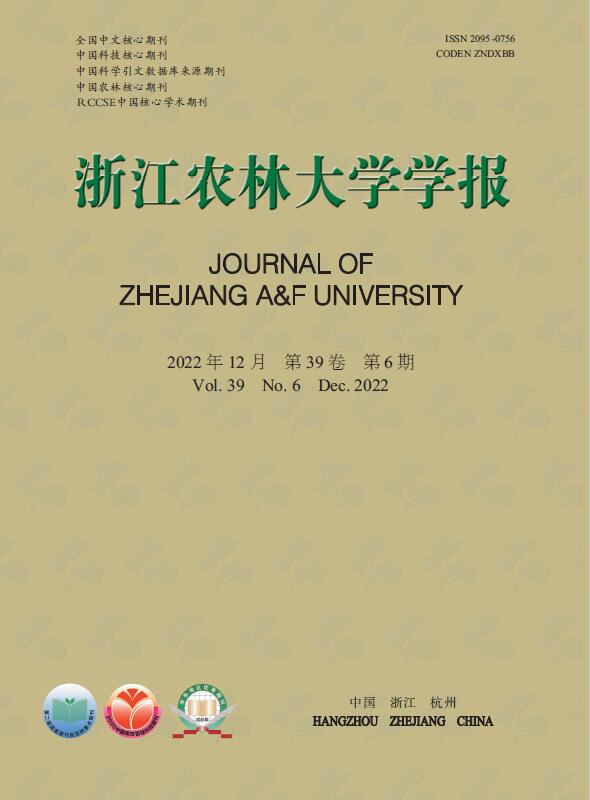-
国外学者于20世纪60年代首次发现挥发性有机化合物(VOCs)[1],之后逐步在VOCs的合成、调控及功能等方面开展研究。中国学者从20世纪80年代开始对VOCs开展研究[2–4],主要在室内空气污染、工业污染治理、VOCs释放调查分析及测定技术等方面。王泰等[5]分析了工业乡村混合区VOCs垂直分布特征,得出受环境影响,各高度VOCs释放量和组分差异明显。王峰等[6]研究了VOCs源不确定性对臭氧生成及污染防治的影响,发现VOCs源不确定性影响臭氧(O3)形成过程中NOx和VOCs 敏感区的判断。随着环境问题日益严重,VOCs成为研究热点。VOCs按来源分可以分为人为源和植物源,植物源是全球VOCs的最大来源,约占VOCs总释放的90%[3, 7-8]。国内VOCs相关综述主要在人为源VOCs方面的吸附、治理等[9-11],而对于植物遭受胁迫后,VOCs合成与释放及在植物中的作用尚缺乏相关综述。
植物VOCs主要分为萜类、苯类、苯丙类化合物和脂肪酸衍生物,它们通常是具有低分子量高蒸汽压的亲脂性液体,可以通过膜自由穿梭,在没有扩散屏障的情况下释放到环境中[12-13]。在不同环境中植物VOCs释放发生改变,高温条件下单萜、倍半萜和酚类释放减少,储存在导管中的单萜释放增加,绿叶挥发物(GLVs)释放增加[13-19],机械损伤后GLVs释放量增加[20-23]。在生物胁迫中,单萜、倍半萜释放增加[24-28]。植物释放VOCs能够帮助植物抵御恶劣环境,也可参与植物直接防御和间接防御。此外,植物VOCs参与大气化学反应,如在臭氧产生和二次气溶胶形成中发挥作用[29-31]。因此,全面了解植物VOCs释放及作用对环境治理具有重要意义。本研究综述了植物VOCs释放受不同环境因素的影响,同时对植物VOCs的合成及储存、生理生态作用进行剖析,为推进植物VOCs领域相关研究提供参考。
-
植物VOCs中第一大类是萜类,它们是由2个独立且细胞分区不同的甲基赤藓糖磷酸(methylerythritol phosphate , MEP)途径和甲羟戊酸(mevalonic acid , MVA)途径合成[32-34]。MEP途径位于质体中,包括7步酶促反应,从丙酮酸和甘油醛-3-磷酸(G3P)缩合开始,主要合成挥发性的异戊二烯、单萜和二萜[33-34]。最近研究表明:在金鱼草Antirrhinum majus花中,倍半萜类的生物合成由MEP途径单独完成[35]。MVA途径位于细胞质、过氧化物酶体和线粒体中,包括6种酶促反应,从乙酰辅酶A开始,主要合成挥发性的倍半萜和三萜[34]。MEP和MVA途径之间通过转运体连接,目前,这些转运体还有待进一步研究。植物VOCs的第二大类是苯丙类、苯类,主要分为苯丙烷类、苯类和苯丙类相关化合物[36]。它们的生物合成来自于莽草酸途径产生的苯丙氨酸(phenylalanine, Phe),苯丙烷类直接通过Phe合成,苯类和苯丙类相关化合物通过β氧化、非β氧化或者两者结合的方式合成[37],合成苯丙烷类的基因和酶还需进一步探究。植物VOCs的第三大类是脂肪酸衍生物,包括GLVs和茉莉酸甲酯等,它们由C18不饱和脂肪酸通过脂氧合酶途径合成[38-39]。不饱和脂肪酸进行定向立体氧化形成C13和C9的氢过氧化物中间体,进而在裂解酶作用下形成GLVs,而C13中间体通过环化形成茉莉酸,进而形成茉莉酸甲酯[39]。
-
大部分植物VOCs合成后储存并积累在不同的组织结构和细胞中,针叶树储存在导管、树脂管[40]或韧皮薄壁细胞簇[41];被子植物储存在叶片油腺细胞或腺体[42]。在叶片中VOCs的存储方式有2种:第1种是指特异性储存的VOCs,包括萜类和非萜类化合物(主要是苯类化合物),它们在叶片中达到较高含量,并且储存是永久性的;第2种是非特定储存的化合物,它们暂时以非常小的含量储存在叶片水相和脂相中,包括水溶性VOCs (如GLVs、丙酮、乙醛、甲醇和芳樟醇等)以及大多数疏水性单萜和倍半萜[43]。
植物几乎所有的器官都释放VOCs[44-45]。大部分VOCs释放发生在植物整个生命周期中,或者特定的发育阶段(如叶片成熟、衰老、花开放和果实成熟)[46]。其他VOCs释放在生物胁迫或非生物胁迫影响后诱导产生。胁迫引起的植物VOCs释放有2种:一种是立即释放,包括储存在特定结构(如针叶树的导管、薄荷Mentha canadensis的腺体等[40, 47])中VOCs的释放,释放原因与胁迫后VOCs的饱和蒸气压发生改变有关,这类VOCs包括单萜、倍半萜,它们在植物抵御胁迫中直接发挥作用或作为信号分子;另一种是很长时间后的释放,即诱导生物合成途径产生VOCs并释放,释放原因与胁迫后能量和碳底物再分配有关,诱导产生的VOCs包括GLVs及萜类等,它们在植物启动防御反应中发挥作用[22]。
-
当植物受到食草昆虫破坏时,营养组织释放出VOCs[24-27],NYKÄNEN等[48]对1980—2000年的数据分析指出:当食草昆虫啃食对植物造成损伤时,植物体内产生的VOCs会有一部分挥发性特别强。植物释放VOCs种类由植物和昆虫种类不同而异:螨虫Eriophyes mites感染椴树Tilia cordata、舞毒蛾Lymantria dispar取食夏栎Quercus robur以及桃蚜Myzus persicae侵害桃树Prunus persica后,单萜、倍半萜及GLVs释放增加[26−27, 49]。舞毒蛾幼虫取食冬青栎Quercus ilex后,茉莉酸甲酯释放增加[22]。白星花金龟侵害玉米Zea mays后,2-甲基丙醇、2-甲基丁醇和顺-3-己烯醇显著增加,它们的释放可能与储存结构中饱和蒸气压改变有关或依赖于生物合成中相关基因表达水平上调有关。而COPOLOVICI等[26]研究发现舞毒蛾取食夏栎后,异戊二烯释放量减少7倍多。
除了食草动物以外,真菌、细菌等病原体感染也会影响植物VOCs释放。锈菌Melampsora epitea侵染杂交柳树Salix burjatica× S. dasyclados后,异戊二烯释放减少,单萜中β-罗勒烯释放增加,总单萜释放量无明显变化,倍半萜和GLVs增加,侵染后6 d,VOCs释放量增加到未侵染时的6倍[28]。线虫Xiphinema index侵染葡萄Vitis vinifera后,β-罗勒烯和柠檬烯释放减少,α-法尼烯和α-佛手烯释放增加[50]。镰刀菌Fusarium spp.侵染小麦Triticum aestivum后,(Z)-3-己烯醛、(E)-2-己烯醛、(E)-2-己烯醇以及芳樟醇和香叶烯释放增加[51]。真菌、细菌等病原体侵染植物后,异戊二烯释放减少,倍半萜及GLVs释放增加。
此外,植物互作对VOCs释放的影响也有研究,但是相对较少[52−53]。桦树Betula verrucosa叶片接收邻近植物产生的VOCs信号并释放特定VOCs以防御食草动物[54]。受损叶片会启动或诱导同一植物的完整叶片或附近未受攻击的植物的防御反应,同一植物完整叶片及邻近植物VOCs释放增加[55−56]。
-
光照是影响植物VOCs释放的重要环境因子,不同VOCs释放的光依赖性不同。异戊二烯、β-罗勒烯等组成型VOCs释放依赖于光照,光照强度增加,异戊二烯的释放速率增加,叶片迅速黑暗处理时,异戊二烯的释放量迅速下降至接近零[57]。GUENTHER等[58]研究发现植物释放异戊二烯对光照依赖性与电子传递密切相关。意大利五针松Pinus pinea释放β-罗勒烯依赖于光照[23]。百合Lilium brownii ‘Siberia’花花瓣中单萜的生物合成和释放受光照的影响,光照强度增加触发Ca2+进入细胞质,MEP途径下游单萜合成酶的基因表达被激活,从而调节单萜的生物合成和释放[59]。而储存在导管或油腺细胞中单萜释放不受光照的影响,光照和黑暗都释放,如α-蒎烯、D-柠檬烯[23]。诱导型VOCs释放随着光照增加而增加。番茄Lycopersicon esculentum伞形烯释放随着连续光照胁迫而增加[60],这种化合物可能是由叶绿体中的光合碳形成,与储存在树脂导管中的其他单萜来源不同。
-
CO2是进行光合作用的重要基础物质,CO2浓度影响植物VOCs释放。在较低CO2浓度下,针叶中边合成边释放的芳樟醇和β-法尼烯增加。CO2浓度升高,美洲黑杨Populus deltoides异戊二烯释放减少,这是由于高CO2浓度提高了光合作用,加速植物初级代谢物的积累,碳源更多的偏向初级代谢产物的合成[61]。CO2浓度增加,植物储存结构中VOCs释放增加[62]。CO2浓度升高,樟子松Pinus sylvestris幼树针叶中α-蒎烯释放增加[63]。在高CO2条件下的高光合碳促进柠檬烯的释放。而HUANG等[64]研究发现:CO2浓度改变,在挪威云杉Picea abies针叶中储存的单萜成分保持不变。CO2浓度过高,部分VOCs释放受到抑制。CO2质量浓度为700 mg·L−1时,冬青栎3种单萜合酶活性下降,导致α-蒎烯、β-蒎烯和桧烯释放受到一定程度抑制[65]。
-
温度也是影响植物VOCs释放的重要因素。高温下,组成型VOCs释放降低。高温条件下,玉米中边合成边释放的单萜、倍半萜和酚类化合物降低[66]。温度高于45 ℃时,植物释放异戊二烯降低[15]。这是由于当温度高于最适温度时,初级代谢下调或受损,进入MEP途径的光合代谢物供应不足,萜类合成受到抑制。而高温条件,储存型和诱导型VOCs释放增加。随温度升高,挪威云杉单萜和倍半萜释放量增加。温度升高,桉树α-蒎烯释放增加[58]。温度高于45 ℃时,植物释放单萜和GLVs增加[15]。这是由于温度影响植物存储结构中VOCs的饱和蒸汽压,而高温诱导合成途径产生新的VOCs。叶肉细胞中具有临时池可储存一些VOCs,这些VOCs是在浓度驱动下释放,受到气孔导度的限制,高温会影响气孔导度的开合进而影响临时池中VOCs的释放[44]。
-
水分是植物生长所必需的因素,水分缺失影响植物VOCs释放。干旱诱导桦树Betula pendula GLVs大量释放,干旱胁迫前2 d,α-蒎烯和桧烯释放增加。干旱胁迫夏栎和黑樱桃Prunus serotina,异戊二烯和水杨酸甲酯释放增加[67]。PARVEEN等[68]研究发现:短期干旱胁迫后,异戊二烯释放增加是因为转录后调控异戊二烯合酶活性影响异戊二烯释放。轻度干旱胁迫下,植物可通过生理调节而不影响植物VOCs的释放;中度干旱胁迫下,植物为了保护细胞抵抗干旱胁迫将更多碳底物分配给VOCs合成,VOCs释放增加;重度干旱胁迫,植物细胞受损,VOCs释放减少[68],如在严重干旱胁迫下,由于缺乏碳底物和(或)ATP,限制冬青栎单萜的合成,复水后,释放立即恢复,但释放水平低于正常水平[69]。
-
机械损伤代表植物受到伤害的临界胁迫,也会影响植物VOCs的释放。机械损伤的植物叶片,储存型VOCs和诱导型VOCs释放增加。通过机械损伤模拟食草动物伤害的研究表明:械损伤后GLVs和单萜释放增加[70]。无论是光照还是黑暗下,机械损伤的针叶导管中单萜类大量释放,主要是柠檬烯和α-蒎烯[23]。FEDERICO等[20]研究发现:机械损伤后GLVs释放瞬时大量增加。HU等[59]研究发现:机械损伤后,杂交杨树Populus simonii×P. pyramidalis释放醛类显著增强,随着时间的变化,这些醛类释放出现2个峰。机械损伤后,植物释放1,8-桉树脑、α-蒎烯和对伞花烃等储存在油细胞中的VOCs、以及(Z)-3-乙酸己烯酯、(E)-2-己烯醛和(Z)-3-己烯-1-醇等诱导产生的VOCs[71]。ASAI等[72]研究发现:机械损伤后,不同柑橘Citrus reticulata损伤叶片都诱导了α-法尼烯释放。
-
生物因素对植物VOCs的释放不尽相同。病原体感染与食草动物取食后,同一植物释放VOCs种类差异明显。桦树被食草动物取食后,释放VOCs种类有罗勒烯、(E)-4,8-二甲基-1,3,7-壬三烯(DMNT)、芳樟醇和茉莉酸甲酯,而真菌感染后,释放VOCs种类只有罗勒烯和芳樟醇[73]。花生Arachis hypogaea被食草动物取食后仅诱导DMNT,而病原体感染后,VOCs释放种类包括DMNT和水杨酸甲酯[74]。玉米被真菌感染使仅由鳞翅目Lepidoptera昆虫诱导的VOCs释放降低了约50%[75]。
非生物胁迫交互作用中,高温和干旱是夏季影响植物VOCs的主要因素,两者交互作用下,植物VOCs释放增加。刺槐Robinia pseudoacacia异戊二烯释放量增加6~8倍,产生的碳损失相当于同化碳的12%~20%[16]。STAUDT等[17]研究表明:高温和干旱复合胁迫短叶栎Q. pubescens和冬青栎释放异戊二烯增加。在25和35 ℃进行干旱胁迫时,黑杨Populus nigra 释放异戊二烯只有在干旱时间延长时减少,这表明在中度干旱胁迫以及2种温度下,黑杨释放异戊二烯在转录或转录后水平上受到更严格的控制[18]。此外,臭氧与其他胁迫交互作用时,植物VOCs释放受臭氧影响更为明显。不同胁迫下植物释放VOCs随臭氧剂量的变化而变化[30]。干旱与低CO2浓度交互作用时,薄荷中单萜浓度保持相对恒定[76]。
生物与非生物胁迫交互作用下,植物VOCs释放增强。在较高光照强度下受病原体感染的小麦释放VOCs成倍增加[51]。涝害胁迫与病原体感染交互作用时,在一定范围内随着湿度增加,受感染小麦释放VOCs增加[77]。涝害胁迫与食草动物取食交互作用时,蚕豆Vicia faba VOCs释放增加,并吸引了食草动物卵的寄生虫[78]。干旱与昆虫取食交互作用时,欧洲桤木Alnus glutinosa GLVs和单萜释放更强且更早达到最大值,并诱导水杨酸甲酯释放,这表明干旱和草食动物联合胁迫下植物对草食动物的抗性更强[79]。臭氧与机械损伤交互作用时,桉树叶片释放组成性VOCs (异戊二烯)增加,释放诱导型VOCs (LOX产物、萜类和苯类)增加,进一步说明了交互作用在诱导型VOCs释放响应中的重要作用[31]。
-
植物通过释放有毒、趋避、反营养的VOCs,防御食草动物和病原体,是一种自我保护。在棉花Gossypium hirsutum中,杜松烯的衍生物棉酚可防御病虫害,体外实验中,发现大量挥发性萜类具有抗微生物的活性[80]。β-石竹烯在拟南芥Arabidopsis thaliana防御病原菌中起到重要作用[81]。除此之外,植物释放VOCs能吸引食草动物的天敌,如寄生蜂Parasitoid wasp或捕食性螨Phytoseiulus persimilis,保护信号植物免受进一步伤害[82]。1980年,PRICE等[83]首次提出植物-昆虫-天敌的三级营养关系,随后DICKE[84]系统地研究并确定了植食性昆虫诱导的植物挥发物(herbivore-induced plant volatiles,HIPVs)在三级营养关系中的信号功能。植物叶片上的昆虫卵可诱导植物释放HIPVs,吸引寄生蜂,保护植物免受其他昆虫伤害。植物释放萜烯具有很强的特异性,过表达萜烯合成酶的转基因植物在三级营养关系中具有相关作用[85],水稻Oryza sativa中,芳樟醇和β-石竹烯的合成酶不表达时,会引起特定昆虫的聚集,而水稻合成并释放芳樟醇和β-石竹烯能吸引昆虫的捕食者,这突出了植物VOCs在决定昆虫群落结构中的重要性[86]。
VOCs信号在植物间的传递有4个步骤:当食草动物攻击植物后,植物受损组织释放信号、信号传输、同一或邻近植物接收信号并做出相应防御反应。早在1983年已经发现植物受损组织释放VOCs可能刺激邻近植物发生变化,影响植食性昆虫摄食[87],二斑叶螨Tetranychus urticae攻击植物后,植物释放VOCs可吸引捕食性螨,VOCs作为线索被邻近植物接收,使邻近植物对斑叶螨敏感性降低[88]。食草动物攻击植物,既可诱导局部受损组织释放VOCs,也可诱导系统性未受损组织释放VOCs,并且释放呈现不同的时间模式[89]。烟草Nicotiana tabacum只在夜间释放几种由食草动物诱导的VOCs,它们能击退在夜间寻找产卵的烟芽夜蛾Heliothis virescens[90]。植物释放的VOCs对邻近竞争性植物的萌发、生长和发育能起到化感作用[91]。在自然界中,植物面对许多不同的线索和信号,可以影响或改变植物VOCs生理特征,从而改变它们与邻近植物的相互作用。
-
VOCs在植物抵御非生物胁迫中也有重要的作用。植物释放异戊二烯使其具有较高的耐热性[14-15],红栎Quercus rubra和葛Pueraria lobata叶片用膦胺霉素处理后,短暂高温胁迫光合作用受到抑制,再用外源异戊二烯熏蒸后,光合作用有一定程度的恢复[92],挥发性萜类可保护植物光合器官和光合作用,从而增强植物在高温下的耐热性[93],膦胺霉素抑制冬青栎叶片单萜合成,冬青栎叶片光合耐热性下降,而单萜熏蒸后,冬青栎叶片耐热性部分恢复[94]。VOCs也具有抗氧化作用,在强光、高温和严重干旱下,植物释放的异戊二烯可抵御光氧化胁迫[19],在受氧化应激的植物中,异戊二烯可淬灭氮活性物质,也可以作为信使分子发挥重要作用[95],植物异戊二烯的生物合成受到抑制后,光合作用下降、活性氧积累并且细胞膜迅速过氧化,表明异戊二烯可保护叶片免受氧化损伤,当膦胺霉素抑制植物单萜类合成时,冬青栎对臭氧很敏感;释放异戊二烯的转基因烟草比非释放异戊二烯的野生型烟草对臭氧毒性更具有抗性[96]。
-
在过去的几十年里,国内外对植物VOCs生物合成、储存、释放和功能等方面研究较多,并在植物适应环境与生物防御和抵抗非生物胁迫的生理生态中的作用等方面取得了重要进展。但是,目前对植物VOCs生物合成和释放的分子调控机制研究较少,复合环境因子交互作用对植物VOCs释放及其影响机制等方面研究还处于初步探索阶段。随着全球气温升高,大气CO2浓度升高,以及极端天气的频发,研究多种环境因子对VOCs释放的影响,有助于进一步探究植物-环境间相互作用和植物VOCs的释放变化如何影响环境,进而为保护环境提供新的思路。
Roles of volatile organic compounds in plant adaptation to stress and physiological ecology
doi: 10.11833/j.issn.2095-0756.20220180
- Received Date: 2022-02-25
- Accepted Date: 2022-09-14
- Rev Recd Date: 2022-09-21
- Available Online: 2023-06-05
- Publish Date: 2022-12-20
-
Key words:
- plant /
- VOCs /
- biosynthesis /
- biotic factors /
- abiotic factors /
- review
Abstract: Volatile organic compounds (VOCs) are lipophilic liquids with low molecular weight and high vapor pressure. According to the source, VOCs can be divided into anthropogenic sources and plant sources, and plant sources are the largest source of VOCs in the global atmosphere. VOCs release from plants is obviously affected by biological and abiotic factors, which play an important role in atmospheric chemical reactions, human health and plant physiology and ecology. However, the effects of complex environmental conditions on VOCs release from plants and their physiological and ecological roles are still not fully understood. In this paper, the synthesis pathways of VOCs in plants are summarized, the effects of single and compound environmental factors on VOCs species and release amount are emphasized, and the role of VOCs in physiology and ecology is summarized. In conclusion, the synthesis pathway of VOCs in plants has been clarified, but the molecular mechanism of VOCs regulation needs to be further explored. Insect feeding, high temperature, drought and high CO2 concentration can reduce the release of constituent VOCs (such as isoprene), increase the release of storage VOCs (such as pinene and limonene), and induce the synthesis and release of new compounds (such as GLVs). However, the effects of complex environment on VOCs release are complex and need to be further explored. VOCs play a role in plant defense against herbivores or attracting herbivores’ natural enemies, mediating interplant signal transduction, anti-oxidation, drought resistance and enhancing plant heat resistance, etc. It is predicted that more roles of plant VOCs in ecosystem will be explored in the future. [Ch, 96 ref.]
| Citation: | HU Shujing, ZHANG Rumin. Roles of volatile organic compounds in plant adaptation to stress and physiological ecology[J]. Journal of Zhejiang A&F University, 2022, 39(6): 1378-1387. DOI: 10.11833/j.issn.2095-0756.20220180 |









 DownLoad:
DownLoad: